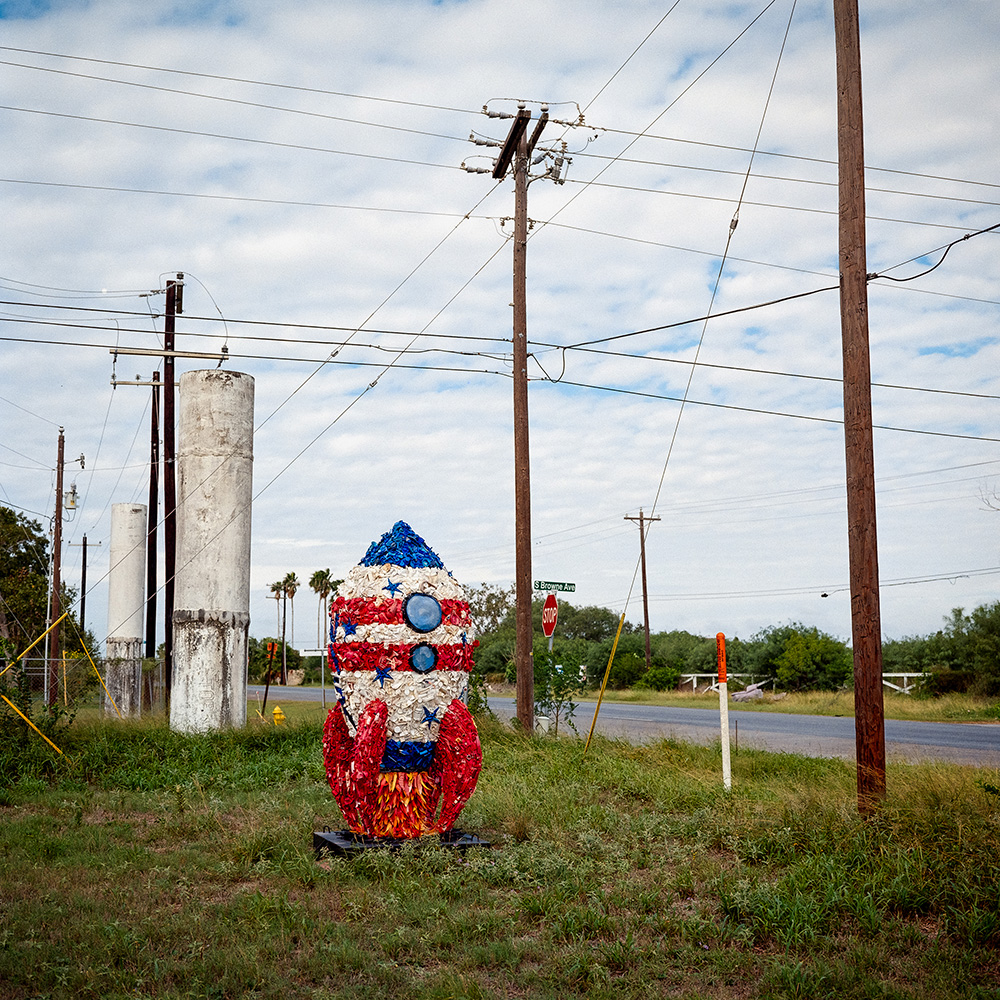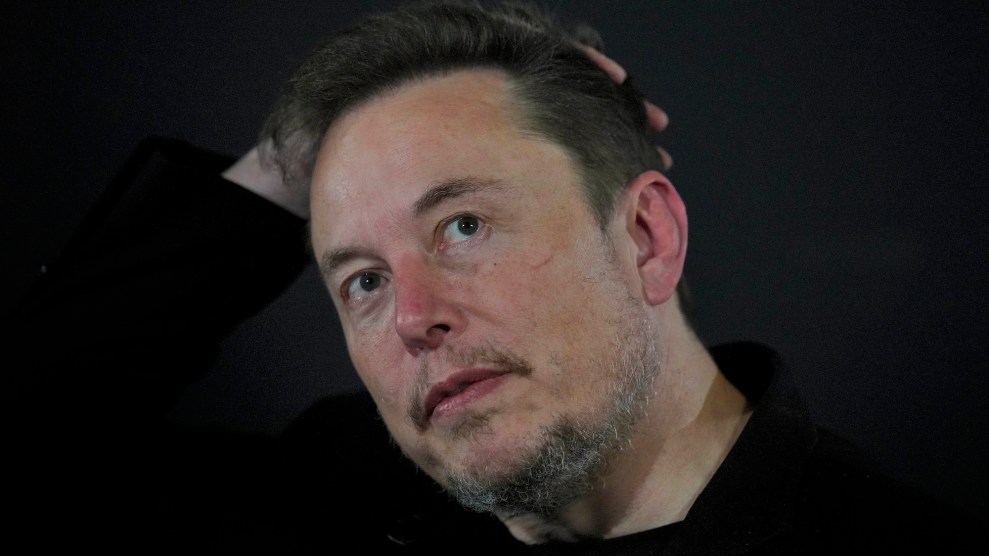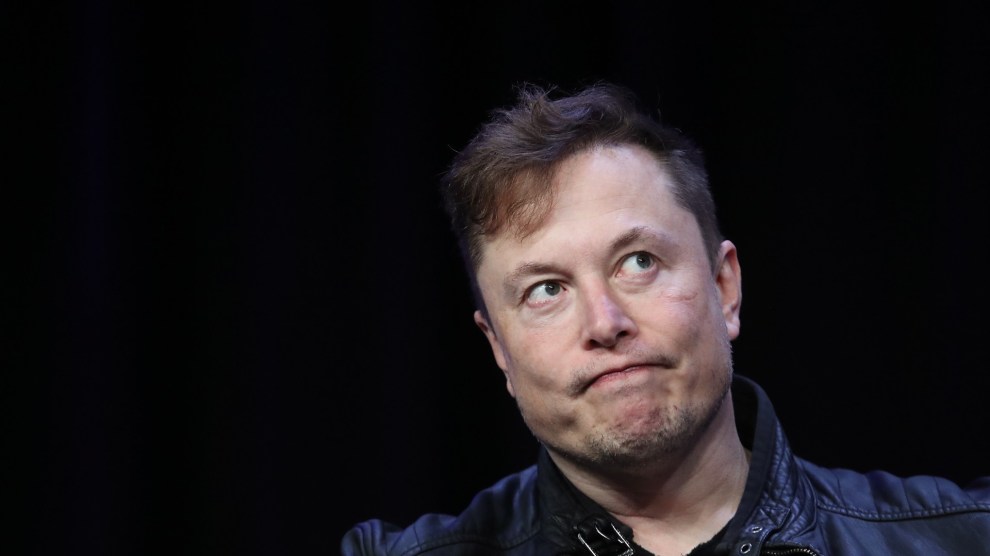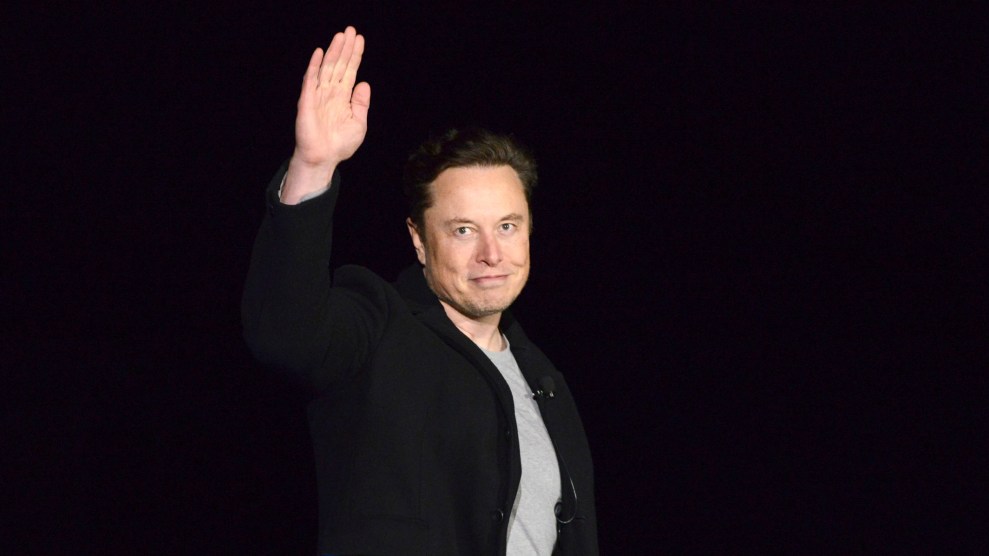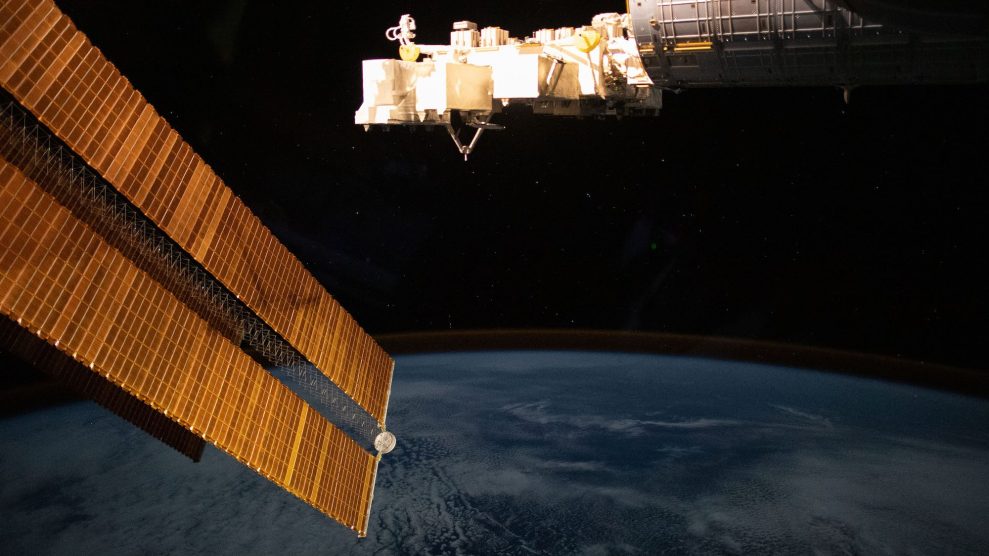When the US targeted Russia’s oligarchs after the invasion of Ukraine, the trail of assets kept leading to our own backyard. Not only had our nation become a haven for shady foreign money, but we were also incubating a familiar class of yacht-owning, industry-dominating, resource-extracting billionaires. In the January + February 2024 issue of our magazine, we investigate the rise of American Oligarchy—and what it means for the rest of us. You can read all the pieces here.
On the morning of April 20, the world’s largest rocket blasted off from Starbase, the SpaceX launch facility in Boca Chica, near the southernmost tip of Texas. Dubbed Starship, the 397-foot craft was expected to reach a cruising altitude of 792,000 feet and circumnavigate the globe in 90 minutes, traveling at near-orbital speeds.
But from the start, things didn’t go as planned. The liftoff excavated a gaping crater in the launchpad, hurling debris thousands of feet and igniting a three-and-a-half-acre fire. Things worsened from there: Shortly into the flight, Starship’s booster failed to detach, and the rocket tumbled back toward Earth, finally exploding above the Gulf of Mexico. (A second launch attempt, in November, also resulted in the explosion of what is supposed to be a “fully reusable” rocket system.)
As Starship transformed into a fireball, a jubilant crowd of SpaceX employees at the company’s California headquarters erupted into applause and popped a champagne bottle, as a table of three SpaceX engineers livestreamed the launch like a sporting event. “What an exciting morning. Oh my gosh. We had a successful liftoff,” one of them said after the rocket went down in flames. “Today was amazing.”
The mood in the communities surrounding Starbase was less joyous. The blast shook buildings and shattered the window of a local gym. Particles fell from the sky, coating cars, houses, and schools. “It felt like an earthquake,” says Sharon Almaguer, who was home in Port Isabel, the small city across the bay from the launchpad. “My 80-year-old mother was terrified.”
Almaguer’s fear turned to anger as the shaking subsided and the rain cleansed her home of launch debris. Not only did it seem that Elon Musk and his company were forgoing basic safety precautions, evading environmental regulations, and obstructing their beach rights as he pursued his quest for interplanetary space travel, but she and her fellow Texans were subsidizing him in the process.
A decade earlier, wearing a dark suit and fiddling with his microphone, Musk had appeared before the state legislature’s House Committee on Appropriations to ask for “any support Texas can offer” to bring a SpaceX facility to their state. And he implied he might take his business elsewhere if the financial perks weren’t enticing enough. “We are looking at other potential launch locations,” he said.
That visit was one of several rendezvous between Musk, his lobbyists, and Texas officials over a three-year campaign to drum up support for a new spaceport for the space exploration company he had founded in 2002.
At the time, a new space age was dawning. No human had visited the moon in nearly 40 years, NASA primarily relied on Russian rockets to transport astronauts to the International Space Station, and Neil Armstrong was bemoaning to congressional committees how the United States was squandering its competitive edge in space. Billionaires, including Musk, were stepping in to fill the void, promising to return the country to its position of dominance.
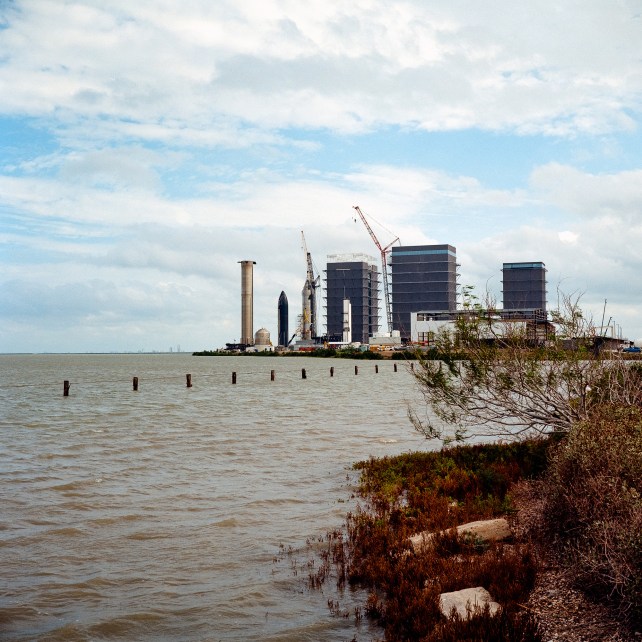
SpaceX launch pad.
Starting in 2006, NASA had offered Musk several large contracts, including one worth $440 million to develop a crew-carrying space capsule. Musk also wanted state and local governments to chip in for his space endeavors. Texas officials, wary of losing SpaceX to another state, offered Musk a pot of enticements worth more than $20 million and a 10-year property tax reprieve. The legislature sweetened the deal by exempting space flight entities from liability for nuisance damages that resulted from rocket launches; they also amended a 1959 law that guaranteed Texans a “free and unrestricted right” to beaches to include an exception for “space flight activities.”
It didn’t matter that SpaceX had seemingly all but decided to move to Texas, already buying up property in Boca Chica, an unincorporated area near the cities of Brownsville and Port Isabel in Cameron County. As SpaceX floated Florida, Georgia, and Puerto Rico as alternative spaceport locations, Texas kept its checkbook handy.
“We’ve moved forward over the past three years and done everything they’ve asked of us,” then–Brownsville Mayor Tony Martinez said in 2014. “We were competitive with whatever Florida was putting together.”
The incentives SpaceX extracted are emblematic of one of Musk’s broader business blueprints: Propose large development projects. Tout their potential to spawn jobs and economic prosperity. Then make the projects conditional on massive subsidies.
Over the past decade, New York has poured nearly $1 billion into Musk’s investment in building one of the Western Hemisphere’s largest solar-panel factories in Buffalo, including leasing 1.2 million square feet of factory space to Tesla for $1 per year. His 1,200-plus-acre lithium refining factory in Robstown, Texas, was dependent on a deal estimated to save Tesla $16.2 million in taxes. Musk’s 2,500-acre Travis County manufacturing hub for the Model Y and Cybertruck electric vehicles was built after Tesla garnered more than $60 million in property tax breaks and rebates in 2020. In a March 2023 deal, Tesla made out with more than $330 million in tax breaks to expand battery facilities and build a semitruck factory just east of Reno, Nevada.
Other tech billionaires have also dangled shiny carrots to reap massive windfalls. In 2017, Amazon famously got 238 cities and states to submit proposals that included economic incentives as they competed to house the company’s second headquarters. Arlington, Virginia, was selected after the state and the county offered to pay Amazon up to $750 million and $23 million in respective subsidies and grants in exchange for new jobs, building occupation, and expected increases in hotel stays due to business needs. (An Amazon spokesperson says receiving incentives from local governments is a standard practice but that it is only one of the factors weighed in the decision to choose Arlington; in most cases, the spokesperson says, the incentives are only paid out after the company reaches demonstrable metrics.) The same year, Taiwanese billionaire Terry Gou, founder of the electronics manufacturer Foxconn, promised his firm would invest $10 billion in a massive Wisconsin factory that would employ 13,000 people in exchange for $3 billion in tax abatements and subsidies.
An offer of a few hundred million in subsidies and abatements pales in comparison to the profits of some of these corporations. But it isn’t small change for the lean state and city budgets from which the savings are drawn. Every dollar in taxes the companies are exempted from is a dollar that doesn’t go to public services. Meanwhile, the profit companies make after getting millions in subsidies “doesn’t trickle down to workers and doesn’t trickle down to the community,” says Kasia Tarczynska, a research analyst at Good Jobs First, a nonprofit that has tracked the proliferation and fallout of these megadeals since 1998.
The playbook that Jeff Bezos, Musk, and others have relied on isn’t new. More than a century ago, the railroad tycoons of the Gilded Age enticed towns to hand them favorable deals in exchange for laying lines that passed through their communities. The supposed benefits of these projects rarely materialized: Many of the promised tracks were never completed, or the routes were discontinued soon after their construction. Worse yet, the towns often had to impose steep new taxes to offset the incentives, triggering a wave of municipal defaults.
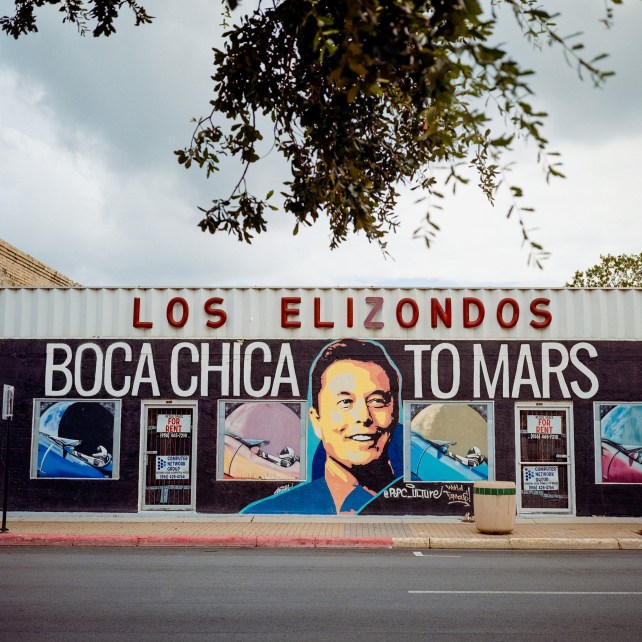
Musk is looking into incorporating Boca Chica, the site of his Starbase.
The trend of unmet promises by corporate titans has continued into the present day. Tesla’s Buffalo plant has created just 54 cents of economic benefit for every subsidy dollar the state invested, a state audit found; the initial contract has been amended several times, extending completion dates and reducing employment targets. Amazon announced it was pausing construction on the second phase of its Virginia headquarters. According to the governor’s office, the number of Wisconsin jobs Foxconn initially promised to create has dwindled by 89 percent. And then there is Boca Chica’s Starbase.
“This is the modern incarnation of the company town. A giant corporation rolls in and asks for a ton of benefits from the community. Supposedly, in exchange, [the town] will receive jobs and economic growth and prosperity,” says Pat Garofalo, the director of state and local policy at the American Economic Liberties Project. “Instead, what happens is that the corporation becomes the quasi-government and uses its power to just continue its extraction: to continue collecting tax breaks, to continue pushing public policy to serve its ends, to continue having public infrastructure built solely for its benefit.”
After SpaceX and its engineers arrived, Brownsville—a border city of 189,000 that is 95 percent Hispanic and is the closest municipality to Starbase—tweaked its motto. “On the Border, By the Sea” became “On the Border, By the Sea, and Beyond,” an ode to Musk’s vision of colonizing Mars. City officials also tried to give Brownsville a hip new nickname, BTX, as if it were the next Austin (sometimes called ATX).
One afternoon in mid-August, I grabbed lunch with Michelle Serrano at a Mexican restaurant in Brownsville called Emilia’s. The spot, which still has an all-Spanish menu, used to bring in mariachi bands to entertain the lunch crowd, but as we chatted, an old white guy was performing “Take Me Home, Country Roads” by John Denver.
The scene struck Serrano, a local activist who works for a pro-immigration and anti-gentrification advocacy group called Voces Unidas, as symbolic of Brownsville’s Musk makeover. The changes were visible not just downtown but outside the city limits as well, where locals had lost their previously unfettered access to Boca Chica Beach thanks to the measure authorizing SpaceX to intermittently close this stretch of coastline.
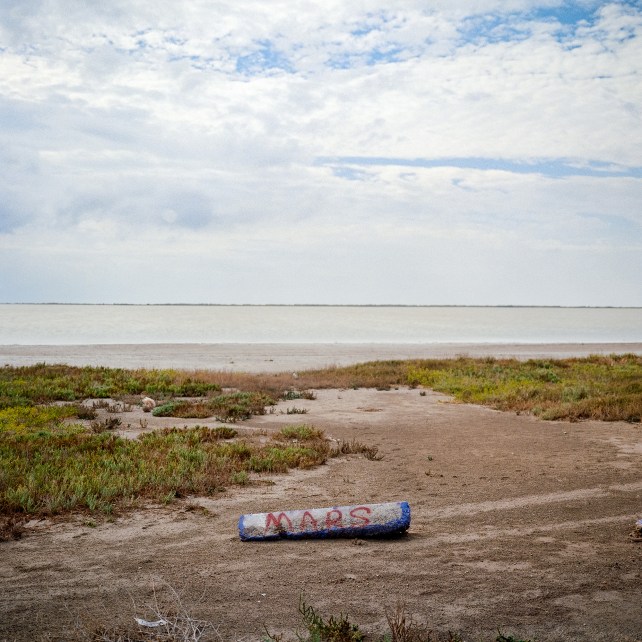
Boca Chica Beach, near the SpaceX launch pad, also known as Elon’s Beach.
“The beach has always been a special privilege to us. It has enriched our quality of life despite the low pay that is available to us,” Serrano said. “Traditionally, people have called it the Poor People’s Beach.” Now, the tourists who visit the shore (when it isn’t closed to beachgoers) to gawk at the SpaceX rockets in the distance have a different name for it, Serrano said: Elon’s Beach.
The sacrifices Brownsville residents made would be rewarded, officials promised, by an economic revival. “We’re actively building a new space ecosystem in Brownsville to attract more space-adjacent companies,” Trey Mendez, who served as the town’s mayor from 2019 to 2023, said in his 2021 State of the City address. Modern space exploration is “projected to be a trillion-dollar industry by 2030, and Brownsville will position itself as a city that welcomes its industry and fosters innovation.”
Later that year, Mendez announced a $1 million, two-year partnership between the city’s economic development nonprofit, funded by a sales tax, and a venture capital advisory firm called 9point8 to attract more space-focused companies to the city. Brownsville was well on its way “to becoming the Silicon Valley of Space,” a press release bragged.
According to a city audit, the economic development nonprofit paid the venture capital firm $500,000 over a six-month period, but the firm never delivered on its contractual promises. Today, there appear to be no space-centric businesses in downtown Brownsville—unless you count the space-themed bar and hot dog stand.
That doesn’t mean SpaceX’s arrival hasn’t benefited anyone. According to the company, as of 2021, it employed at least 1,600 people in the area and had spent $36 million on Cameron County suppliers. Musk has also personally donated to Brownsville. Moments after an early Starship model exploded in March 2021, he announced he would gift $20 million to local schools and $10 million for downtown improvements. At least $2 million went to the Brownsville Community Improvement Corporation (BCIC), which provides grants to local businesses. In September 2021, a company called Urban 8 Properties, LLC, applied for $200,000 to renovate a historic Coca-Cola building. A primary registered agent of the LLC was Mendez, the city’s mayor.
When community watchdogs discovered the potential conflict of interest, Mendez pulled the application. He opted not to run for reelection in 2023, though he never admitted wrongdoing. By this time, however, Mendez, through a separate LLC, had already secured $80,000 from the Musk-backed fund to remodel a different downtown building, BCIC records show. (Mendez didn’t respond to requests for comment from Mother Jones.)
On his Facebook page, Mendez is pictured posing shoulder to shoulder with Musk. On the same social media page, he posted the name, employer, and mugshot of a local activist named Bekah Hinojosa who had allegedly spray-painted “Gentrified. Stop SpaceX” on a Pepto-Bismol-pink BTX mural, also funded by money Musk had donated to the city. “The City of Brownsville takes all crimes, especially those to city property, very seriously,” Mendez wrote just after Hinojosa’s February 2022 arrest.
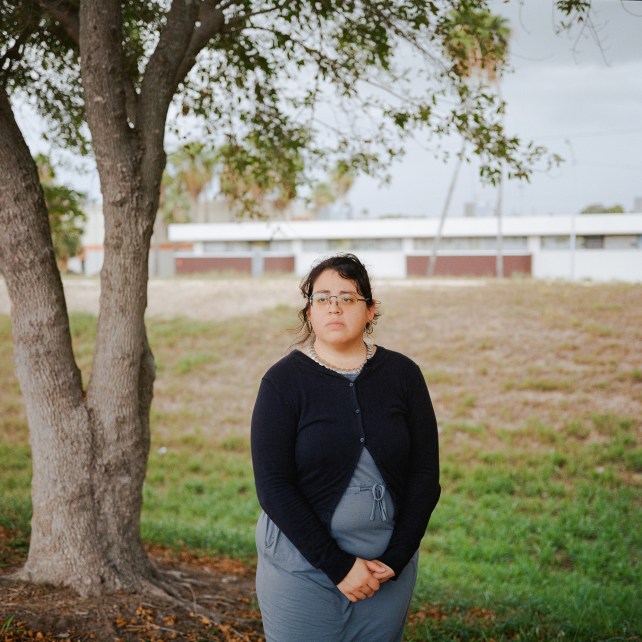
Bekah Hinojosa
Yet this misdemeanor seemed to be taken far more seriously than others. Four police officers had burst into Hinojosa’s apartment to make the arrest, and she was jailed for roughly 26 hours. Graffiti is ubiquitous in Brownsville, but there were only three other class B misdemeanor graffiti charges between July 2019 and August 2022, city records show. None of those cases culminated in the mayor posting on Facebook.
Like the change of music at Emilia’s, Hinojosa senses the outsize reaction to the graffiti allegation was a symbol of Brownsville’s new loyalties. “It feels like the city and the county are listening more to SpaceX and the private space industry wanting to move in, rather than people who have lived here for generations,” she says.
From Brownsville, Boca Chica Beach is a 20-mile straight shot down State Highway 4, an underlit, pothole-filled two-lane road that dead-ends onto sand.
A half-mile from the shoreline, a conservation biologist discovered a declining bird species, the snowy plover, building its nests out of rubble that spewed from the towering SpaceX launchpad when the April 20 launch went awry. The Federal Aviation Administration temporarily grounded future Starship launches, but the fact that SpaceX was allowed to test the rocket at all was baffling to environmental and legal experts. A 1970 law called the National Environmental Policy Act requires the FAA to consider risks to air and water quality before it grants operating permits to private companies. Under the act, large projects are typically subject to environmental impact statements, especially if they are located near rare ecological features or endangered species. Boca Chica Beach, which is part of a US Wildlife Refuge, has both, including the world’s rarest type of sea turtle.
In 2014, after undergoing an environmental impact statement, SpaceX received FAA approval to launch 12 Falcon 9 rockets per year. Soon, though, the company told the FAA it wanted to begin launching the much larger Starship, the world’s most powerful rocket system, with a max payload 11 times greater than Falcon 9’s max. Ordinarily, a change like this would necessitate a new impact statement, argues Jared Margolis, senior attorney for the Center for Biological Diversity. Initially, the FAA had planned to require one, according to government emails cited in a lawsuit against the agency by Margolis’ group, three other environmental organizations, and the indigenous Esto’k Gna tribe that considers the beach sacred ground. (SpaceX is a co-defendant.)
In the end, the FAA “deferred to SpaceX” and decided to forgo a new impact statement, the lawsuit alleges. SpaceX went on to conduct its own environmental assessment, under the FAA’s supervision, and found that Starship would cause no significant environmental effects. That’s hard to square with the risks Musk alluded to ahead of the April launch. “If you have 33 engines and if any one of them goes wrong, it’s like having a box of grenades,” he said during a livestream on Twitter, which Musk now owns. “Really big grenades.” At a 2018 press conference, Musk had seemed blasé about the prospect of one of his rockets exploding, saying, “We’ve got a lot of land with nobody around, and so if it blows up, it’s cool.”
Considering the $16.1 billion in contracts the federal government has handed to SpaceX since 2003, the interests of SpaceX and the agencies counting on the company to fulfill the nation’s space policy goals are increasingly aligned. “We call it agency capture,” says Margolis. “Agencies are not there to protect the public; they’re there to promote the businesses that they regulate, in a lot of ways.”
As Musk’s business portfolio with the US government grows, so does the influence he holds over it. Ronan Farrow explored Musk’s “shadow rule” in an August New Yorker investigation, detailing the US government’s growing dependence on Musk for everything from space travel to renewable energy to the satellite technology that enables Ukrainian troops to communicate on the battlefield. “Current and former officials from NASA, the Department of Defense, the Department of Transportation, the Federal Aviation Administration, and the Occupational Safety and Health Administration told me that Musk’s influence had become inescapable in their work, and several of them said that they now treat him like a sort of unelected official,” Farrow wrote.
A year before the ill-fated April launch, the FAA-supervised environmental assessment predicted a Starship liftoff “could result in an explosion on the launchpad, which would spread debris.” The forecast was not too far off. The launchpad was, in fact, heavily damaged by the launch, as were some of the tanks near the pad designed to hold rocket propellant. Such events could have been avoided, or at least mitigated, had SpaceX installed a water-cooled flame diverter. One day after the launch, Musk said SpaceX had started building such a system but that it wasn’t ready in time for the April 20 takeoff. Nor did the launch site include the flame trenches commonly used by NASA. “Hard to believe Starship actually did launch on 4/20 lol,” Musk wrote on Twitter a few days later, fueling speculation he was eager to launch on the weed holiday.
After the calamitous launch, the FAA permitted SpaceX to conduct its own review of what went wrong under the agency’s supervision. In September, the agency announced that SpaceX needed to take 63 corrective actions before Starship could take flight again. SpaceX was well acquainted with this punch list—the company had led its creation.
A similar theme of regulatory interference has played out on a smaller scale about 350 miles north of Boca Chica in Bastrop County, where Musk has built a testing hub for the Boring Company, his underground tunneling solution to traffic that could eventually extract millions in contracts from state and municipal governments. Violation notices and emails between local officials and company representatives show that the Boring Company has broken numerous local environmental and public safety regulations while apparently seeking fast-track permitting.
The infractions are characteristic of the pressure Musk’s companies routinely apply and the concessions their dominance compels. “I feel a need to express my concerns over the demands being placed on development services staff and myself over the past several months regarding permit applications for the Boring Company,” wrote Bastrop County engineer Robert Pugh to County Commissioner Clara Beckett in June 2022. “We have been regularly hounded by their staff and consultants to expedite and approve permit applications that are incomplete and not in compliance with Commissioners Court (CC) regulations.”
It wasn’t just the Boring Company on Pugh’s back. His team had also been “regularly pressured” by county officials to comply with the Boring Company’s requests. It was particularly frustrating, Pugh wrote, because the Boring Company was “a customer that has not followed CC regulations,” such as by improperly disposing of septic waste. (Pugh left his position later that month.)
Chap Ambrose, a software developer who lives on a 10-acre ranch overlooking the Boring Company’s industrial warehouse, has tracked Musk’s compliance problems for the past two years. The Boring Company’s plans to dump 143,000 gallons of treated wastewater per day into a portion of the Colorado River near his property particularly concern him. The river serves as a habitat for aquatic life, a source of recreation for locals, and a major source of the public water supply.
Although the Boring Company would be required to follow strict state regulations on the contaminants its treated wastewater can contain if the application is approved, Ambrose argues that such rules have rarely stopped Musk’s companies before. “They don’t seem to think the rules apply,” he says, wearing a cowboy hat and well-worn jeans as we sit on his patio.
Soon, the Boring Company may get to make some of its own rules. Last March, the Wall Street Journal reported that Musk had discussed incorporating the area adjacent to the Boring Company’s warehouse, which would enable him to create some municipal laws. At a 2022 all-hands meeting, a company executive mentioned the proposed city, dubbed Snailbrook, would have to hold an election for mayor. Already, the area has placards reading “welcome snailbrook, tx, est. 2021.”
The county told the Journal that it has not yet received an application for incorporation. Per state law, at least 201 residents must live in an area before the process can get underway; the Boring Company may reach that threshold with the 110 homes for which it has filed plans with the county to build. The Journal also reported on correspondence between Bastrop County officials and a company executive about a proposed Montessori school, presumably for the children of employees.
Such plans evoke the image of the company towns created by Gilded Age moguls, who built enclaves that provided housing, schools, and other necessities to workers. In theory, the communities represented utopias, where all the workers’ needs were met. Yet when the almighty companies served as employer, landlord, and quasi-government, their workers had little agency to fight exploitative conditions. The common thread between the past and present iterations is “the private control, by powerful corporate actors and other holders of accumulated wealth, of what might otherwise be public local governance functions subject to democratic accountability,” says Brian Highsmith, a Harvard Law School fellow leading a reading group there on company towns.
Musk has also inquired about incorporating Boca Chica, according to a March 2021 press release. “In the last few days, Cameron County was officially approached by SpaceX regarding Elon Musk’s interest to incorporate Boca Chica Village into the City of Starbase, Texas,” the release noted.
When I submitted records requests for government correspondence relating to Musk’s inquiry, one initial response came not from the county but from a SpaceX lawyer. She was cc’ing me on an email to the Texas Office of the Attorney General and the county seeking to keep those documents concealed. It turned out that in addition to handing SpaceX a 10-year tax abatement, Cameron County had also agreed in the contract to make the best possible efforts to withhold corporate information that would otherwise be subject to open records laws.
Perhaps there was no need to incorporate. It is already a company town.
—Additional reporting by Gaige Davila.
